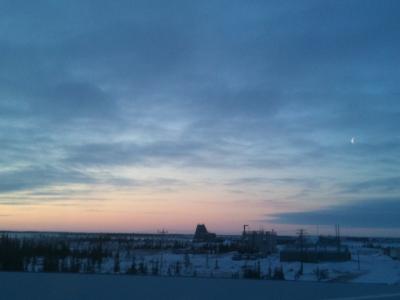Amazing Churchill

Things are getting more and more serious as I start to understand what we will be doing in this volunteer-experience. The first day we were instructed about our daily schedule including time for meals. Breakfast is at 7am, but before, at 6:45, we have a short briefing about the previous day and most importantly - we check out the temperature for the day. Today it was -15C with a sensation of -23C due to the wind-chill. How bad could it be, I thought to myself. After a nice and warm breakfast we had a more in-depth explanation about the samples were supposed to take: 6 in total for each pit. For each sample were using different tools which we also should learn how to calibrate, use and read. Lots of new terms and others not so new, but coming back from my time in university.
After almost 2 hours of lecture we headed outside for the first time. First of all, some time to dress up. I was using quite a few layers and that makes movement more difficult, even indoors. It is somewhat tricky to know exactly what to wear and how to wear it, mainly because you dont really know what and how it is all going to work. Shall I wear the balaclava? First, a glance to my team members to see what they were doing. Though this is also their first time in such weather, so not sure if this is completely helpful. Shall the toque go on top of the balaclava, or vice versa? How many pairs of socks shall I wear? Shall I use hand warmers or would it be better to go outside and see if I really need them? Oh dear. Lets make a vote of trust in the rented equipment and wool long underwear and go outside.
Barely being able to move, very slowly taking my equipment outside, I was able to reach the qamutuk. This is a vehicle used to transport materials and people in these Arctic regions. Its a snowmobile, like a motorcycle but instead of wheels, it uses skies. And hooked up in the back part there is a wooden box where up to 4 people can sit. It looks really cute and Ill make sure to have some pictures of it for the next post. The ride to the field was about 20 minutes felt like 40 because I didnt make it to the cushion and my butt was repeatedly hitting the wood! Coming back I ensured that that didnt happen again and later in the afternoon was also better.
We did some sampling throughout the day: one pit in the morning and two more in the afternoon. Dr. Kershaw says we will be masters on the art of taking snow samples by the time we leave the project. I wish that we could speed up the process of mastering the use of so many tiny tools with the mittens on. And that brings me to the weather conditions. It was really not as cold as one could imagine today. But trying to do this sampling and handling these small equipment was not possible for me with the mittens on. So I had to take them off and then, after a few seconds I could say it was truly cold in my hands. Really cold. Amazingly cold. I put my mittens on again but they were not warm enough. I began moving them, nothing happened. Was time again to remove the mittens for the next test and both hands were freezing. I asked my partner for a waiver and some minutes of waiting till the hands came to life and he said his were also freezing. One of the researchers joining our team said best way to keep them warm was to do some moving. But moving is not the thing you could do with all those layers on you. We searched our pockets for some hand warmers which I already had in each mitten but seemed not to be working properly. We found some and had to of course- remove the mittens to be able to open the little bags, shake the warmers to start them up and put them in the mittens. And mittens on again. By the time we did this I started realizing my feet were cold too. My hands didnt warm up immediately but I felt a bit of a relief so we could continue the sampling thing with help of Krista, a seasonal research technician.
The day ended with a lecture after dinner along with a glass or two of wine- and entering the data from the samples collected during the day. Im reflecting now about those short minutes and Im sure this was not one of the life-threatening conditions that were mentioned in the briefing when I signed up for the expedition. But at that moment, dealing with the unexpected, not having a single clue of what could happen under conditions you have never experienced, it was surely intimidating. Theres an enormous feeling of being a very little tiny part of something amazingly huge, and that consciousness of being affected by something you cant control and that could overwhelm you in matter of seconds.
The most beautiful thing that we can experience is the mysterious
John Denver
0 comentarios